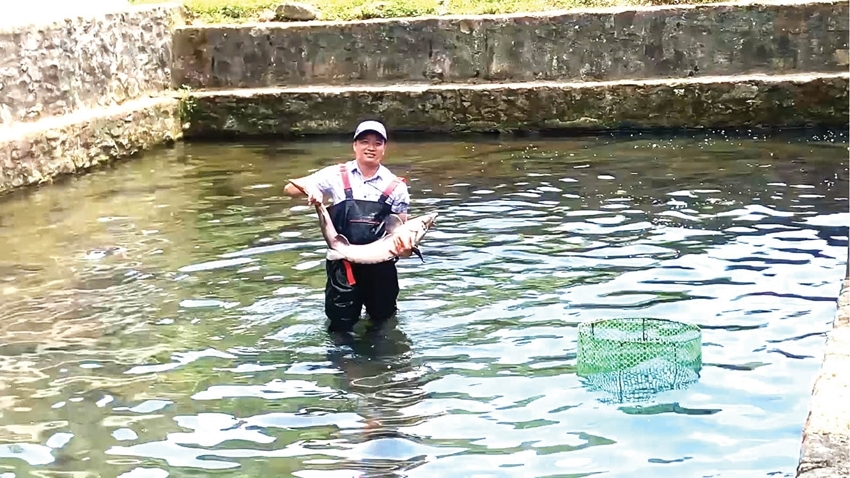 |
| Mr. Ho Thanh Phuong's sturgeon farm (Hong Kim Commune, A Luoi District) |
Strong potential
Research from the Research Institute for Aquaculture No. 1 shows that Siberian sturgeon domesticated in Vietnam can survive in high-temperature conditions. Therefore, sturgeon can be raised in water bodies where the water temperature does not exceed 30°C. In Hue City, the AEC first piloted sturgeon farming in A Luoi District during 2019–2020. After two years, the model showed that the species grew well and adapted to the local water and climate conditions.
The AEC continued surveying various waterfalls and streams in other locations such as Phu Loc and Phong Dien, where the water temperature remains below 26°C year-round, with the aim of expanding the model. However, to sustainably develop the model, a project was needed to assess its potential and finalize the technical procedures for nursery and farming.
Therefore, in 2023, the AEC implemented the project titled “Application of Science and Technology to Develop a Sturgeon Nursery and Farming Model Based on the Value Chain in Mountainous Communes of Hue City”. The goal was to successfully apply scientific and technological advancements to develop sturgeon nursery and farming suitable to local natural conditions and value chains, helping to increase the income of people living in the mountainous areas of Hue City. The project was implemented at three sites, two in A Luoi District and one in Nam Dong District (now Phu Loc District), with nursery scale of 150m² across three sites and farming scale of 1,500m² across the same three sites.
After more than three months implementing the sturgeon nursery model, the survival rate reached 63.3%, with an average weight of 53,6g per fish, yielding 19,000 fingerlings. The survival rate at Mr. Ho Thanh Phuong's farm (Hong Kim Commune, A Luoi) and Huong Nguyen Border Guard Station was 70%, meeting the project’s expectations. The nursery model was officially accepted in April 2024. Currently, the households are continuing to raise the fish until the commercial sturgeon farming phase ends this May.
Mr. Ho Thanh Phuong shared that his family released 10,000 sturgeon fingerlings, achieving a 70% survival rate during the nursery phase, and each fish has now reached 2kg. This new model brings relatively high economic returns and creates local jobs. To expand the farming scale, he believes there must be a stable market, along with additional investment in technical improvements, particularly safe farming solutions during stormy seasons.
Elevating sturgeon farming
Vice Chairman of Hong Kim Commune People’s Committee Ho Van Minh said that the AEC’s sturgeon farming model has opened a new direction for local economic development, helping to improve incomes and create jobs for the community. Hong Kim Commune still has ample potential for sturgeon farming, with its pristine river and stream systems providing favorable conditions for breeding and experimental farming. At the same time, local authorities will continue working with relevant agencies to offer technical training courses, enabling residents to access knowledge and skills to develop the model according to a value chain, ultimately producing branded products.
Director of Hue City AEC, Chau Ngoc Phi, affirmed that along with nursery and farming model implementation, the project has allowed the AEC to assess natural conditions, demand, investment capabilities for nursery and farming, as well as the sturgeon consumption market, providing a basis for future development direction. The AEC has also adopted technical procedures for sturgeon nursery and commercial farming from the Cold-water Fisheries Research Center under the Research Institute for Aquaculture No. 1. Currently, the center is refining the nursery and farming procedures and is working with the Cold-water Fisheries Research Center to train technicians in nursery operations, disease diagnosis, prevention, and treatment for sturgeon.
The AEC has also organized technical training classes on sturgeon nursery for farmers in A Luoi and Phu Loc districts. It has supported the establishment of a traceability system for A Luoi sturgeon at Mr. Nguyen Thanh Phuong’s farm in Hong Kim Commune. In addition, the project has developed a value-chain-based product traceability system for sturgeon by issuing QR codes for products, allowing consumers to verify product information; supported label design and helped model implementation sites link up and sell sturgeon products. Furthermore, the project has provided equipment for environmental monitoring and data collection in farming areas.
According to Mr. Chau Ngoc Phi, during the project implementation process, the AEC placed great emphasis on species surveys and worked with technology transfer units to supply materials such as fingerlings and feed. The center especially focused on technical transfer to help locals understand and take the initiative in long-term production. Moving forward, the AEC will continue collaborating with project implementation sites to complete the remaining activities within the project’s scope and proceed to acceptance and evaluation.